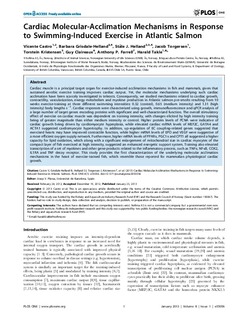| dc.contributor.author | Castro, Vicente | |
| dc.contributor.author | Grisdale-Helland, Barbara | |
| dc.contributor.author | Helland, Ståle | |
| dc.contributor.author | Torgersen, Jacob | |
| dc.contributor.author | Kristensen, Torstein | |
| dc.contributor.author | Claireaux, Guy | |
| dc.contributor.author | Farrell, Anthony P. | |
| dc.contributor.author | Takle, Harald Rune | |
| dc.date.accessioned | 2014-02-27T10:38:18Z | |
| dc.date.accessioned | 2014-03-28T15:29:14Z | |
| dc.date.available | 2014-02-27T10:38:18Z | |
| dc.date.available | 2014-03-28T15:29:14Z | |
| dc.date.issued | 2013 | |
| dc.identifier.citation | Castro, V.,Grisdale-Helland, B.,Helland, S., et al., 2013. Cardiac molecular-acclimation mechanisms in response to swimming-induced exercise in atlantic salmon. PLoS ONE 8(1):1-10 p. http://dx.doi.org10.1371/journal.pone.0055056 | nb_NO |
| dc.identifier.issn | 1932-6203 | |
| dc.identifier.uri | http://hdl.handle.net/11250/193246 | |
| dc.description.abstract | Cardiac muscle is a principal target organ for exercise-induced acclimation mechanisms in fish and mammals, given that sustained aerobic exercise training improves cardiac output. Yet, the molecular mechanisms underlying such cardiac acclimation have been scarcely investigated in teleosts. Consequently, we studied mechanisms related to cardiac growth, contractility, vascularization, energy metabolism and myokine production in Atlantic salmon pre-smolts resulting from 10 weeks exercise-training at three different swimming intensities: 0.32 (control), 0.65 (medium intensity) and 1.31 (high intensity) body lengths s−1. Cardiac responses were characterized using growth, immunofluorescence and qPCR analysis of a large number of target genes encoding proteins with significant and well-characterized function. The overall stimulatory effect of exercise on cardiac muscle was dependent on training intensity, with changes elicited by high intensity training being of greater magnitude than either medium intensity or control. Higher protein levels of PCNA were indicative of cardiac growth being driven by cardiomyocyte hyperplasia, while elevated cardiac mRNA levels of MEF2C, GATA4 and ACTA1 suggested cardiomyocyte hypertrophy. In addition, up-regulation of EC coupling-related genes suggested that exercised hearts may have improved contractile function, while higher mRNA levels of EPO and VEGF were suggestive of a more efficient oxygen supply network. Furthermore, higher mRNA levels of PPARα, PGC1α and CPT1 all suggested a higher capacity for lipid oxidation, which along with a significant enlargement of mitochondrial size in cardiac myocytes of the compact layer of fish exercised at high intensity, suggested an enhanced energetic support system. Training also elevated transcription of a set of myokines and other gene products related to the inflammatory process, such as TNFα, NFκB, COX2, IL1RA and TNF decoy receptor. This study provides the first characterization of the underlying molecular acclimation mechanisms in the heart of exercise-trained fish, which resemble those reported for mammalian physiological cardiac growth. | nb_NO |
| dc.language.iso | eng | nb_NO |
| dc.relation.uri | http://www.plosone.org/article/fetchObject.action?uri=info%3Adoi%2F10.1371%2Fjournal.pone.0055056&representation=PDF | |
| dc.rights | CC by - http://www.plosone.org/static/license | |
| dc.rights.uri | https://creativecommons.org/licenses/by/4.0/ | |
| dc.title | Cardiac molecular-acclimation mechanisms in responseto swimming-induced exercise in atlantic salmon | nb_NO |
| dc.type | Journal article | nb_NO |
| dc.type | Peer reviewed | nb_NO |
| dc.date.updated | 2014-02-27T10:38:18Z | |
| dc.rights.holder | The authors | |
| dc.source.pagenumber | 1-10 | nb_NO |
| dc.source.volume | 8 | nb_NO |
| dc.source.journal | PLoS ONE | nb_NO |
| dc.source.issue | 1 | nb_NO |
| dc.identifier.doi | 10.1371/journal.pone.0055056 | |
| dc.identifier.cristin | 1020653 | |
| dc.rights.license | Attribution 4.0 International (CC BY 4.0) | |

